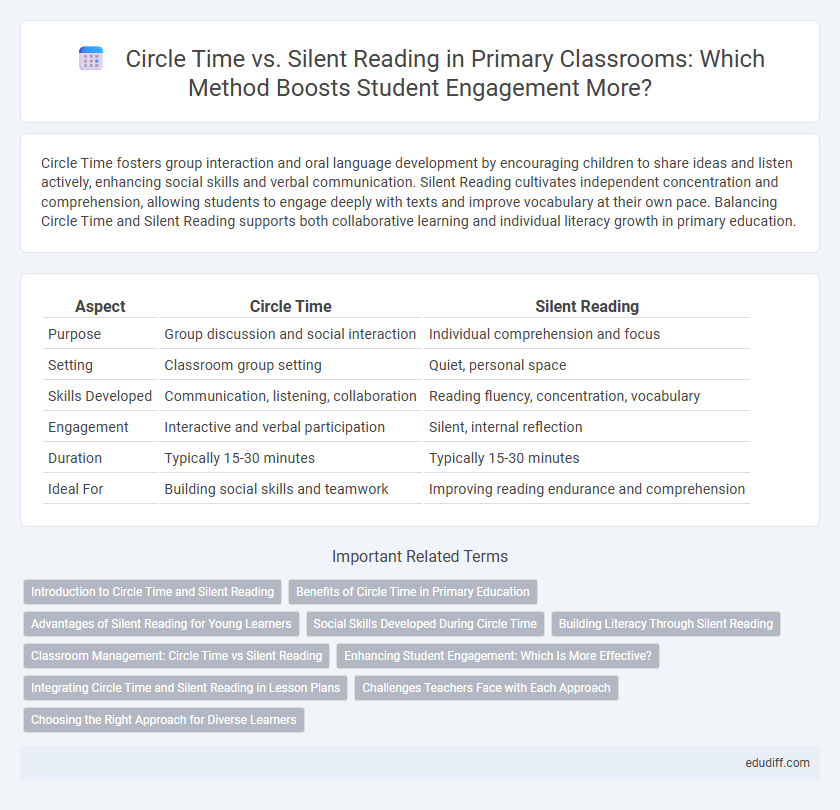Circle Time fosters group interaction and oral language development by encouraging children to share ideas and listen actively, enhancing social skills and verbal communication. Silent Reading cultivates independent concentration and comprehension, allowing students to engage deeply with texts and improve vocabulary at their own pace. Balancing Circle Time and Silent Reading supports both collaborative learning and individual literacy growth in primary education.
Table of Comparison
| Aspect | Circle Time | Silent Reading |
|---|---|---|
| Purpose | Group discussion and social interaction | Individual comprehension and focus |
| Setting | Classroom group setting | Quiet, personal space |
| Skills Developed | Communication, listening, collaboration | Reading fluency, concentration, vocabulary |
| Engagement | Interactive and verbal participation | Silent, internal reflection |
| Duration | Typically 15-30 minutes | Typically 15-30 minutes |
| Ideal For | Building social skills and teamwork | Improving reading endurance and comprehension |
Introduction to Circle Time and Silent Reading
Circle Time promotes interactive learning by encouraging students to participate in group discussions, fostering social skills and collaborative thinking. Silent Reading allows students to independently engage with texts, improving concentration, comprehension, and vocabulary development. Both methods support literacy but emphasize different aspects of cognitive and social growth in primary education.
Benefits of Circle Time in Primary Education
Circle Time fosters social-emotional development by encouraging communication, cooperation, and empathy among primary students. This interactive setting enhances listening skills and builds a supportive classroom community, promoting active participation and confidence in young learners. Engaging in Circle Time also supports language development and critical thinking through group discussions and shared experiences.
Advantages of Silent Reading for Young Learners
Silent reading enhances concentration and fosters independent learning skills in young learners. It supports vocabulary development and comprehension by allowing children to process text at their own pace. This practice encourages a love for reading and improves cognitive abilities essential for academic success.
Social Skills Developed During Circle Time
Circle Time fosters essential social skills such as active listening, turn-taking, and collaborative communication, creating a dynamic environment for peer interaction. Children develop empathy and emotional regulation as they share ideas and respond to others in a group setting. In contrast to Silent Reading, Circle Time emphasizes verbal expression and social engagement, which are critical for early childhood social development.
Building Literacy Through Silent Reading
Silent reading promotes independent literacy development by allowing students to engage deeply with text at their own pace, enhancing comprehension and vocabulary acquisition. Research shows that consistent silent reading practices improve fluency and foster a lifelong reading habit. Unlike Circle Time, which emphasizes social interaction and oral language skills, silent reading targets individual cognitive processing essential for building strong foundational literacy.
Classroom Management: Circle Time vs Silent Reading
Circle Time promotes active classroom management by encouraging student engagement, turn-taking, and verbal interaction, fostering a collaborative learning environment. Silent Reading supports independent management, allowing students to self-regulate and develop concentration skills while teachers monitor progress quietly. Balancing Circle Time and Silent Reading optimizes classroom dynamics by integrating social interaction with focused individual learning.
Enhancing Student Engagement: Which Is More Effective?
Circle Time fosters student engagement by encouraging interactive dialogue and peer collaboration, which boosts social skills and active participation. Silent Reading promotes individual focus and comprehension, allowing students to internalize material at their own pace, but may limit immediate feedback and social interaction. Research indicates that combining Circle Time's dynamic interaction with Silent Reading's concentration can effectively balance engagement and literacy development.
Integrating Circle Time and Silent Reading in Lesson Plans
Integrating Circle Time and Silent Reading in lesson plans enhances student engagement and comprehension by balancing interactive discussion with focused independent reading. Circle Time fosters social-emotional skills and verbal expression, while Silent Reading develops concentration and literacy fluency. Combining these methods creates a holistic learning environment that supports diverse learning styles and improves overall academic achievement.
Challenges Teachers Face with Each Approach
Teachers face challenges with Circle Time due to managing diverse student participation and maintaining engagement in large groups, which can hinder the flow of discussion. Silent Reading poses difficulties in monitoring individual comprehension and keeping students focused without direct interaction. Balancing these challenges requires tailored strategies to meet varied learning needs and classroom dynamics efficiently.
Choosing the Right Approach for Diverse Learners
Circle Time promotes social interaction and verbal expression, benefiting students who thrive in collaborative and auditory learning environments. Silent Reading supports independent comprehension and focus, ideal for learners who excel in quiet, self-paced activities. Selecting the right approach depends on understanding students' individual learning preferences and balancing opportunities for both group engagement and solitary reflection.
Circle Time vs Silent Reading Infographic

 edudiff.com
edudiff.com